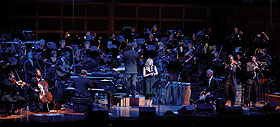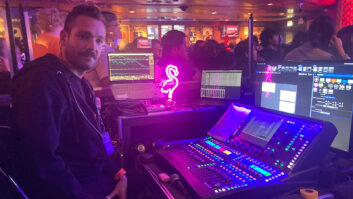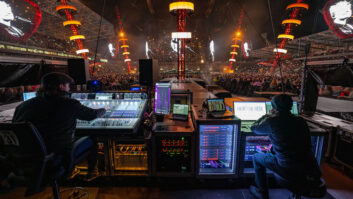
Photos: Steve Jennings

Front-of-house engineer Pete Plympton at the Yamaha PM5D console, supplied by Sound on Stage
Mixing for a 12-piece band can be challenging in itself—especially one that smoothly transitions from Cuban jazz to classical chamber music—but when Pink Martini throws in a full symphony orchestra, front-of-house engineer Pete Plympton’s board becomes quite full. Fortunately, Plympton isn’t about to break a sweat, having been one of the studio engineers on the band’s first album back in 1997 and having done their live sound ever since. Mix caught up with the crew at a July performance at San Francisco Davies Symphony Hall with the San Francisco Symphony.
The tour is not carrying full production; at the S.F. show, local sound company Sound on Stage augmented what was installed at the venue, including a Yamaha PM5D board. Keeping FOH ground control at a slimmed-down size, Plympton uses all onboard effects; when working on an Avid Profile, he employs Waves PS-22 on guitars, McDSP 2000 on brass and vocals, TC Electronic VSS3 reverb and a Tube-Tech compressor on the “unruly things,” he says. “I do love the sound and looks of a Midas XL4, but I would be thrilled to never use analog again.”
The house P.A. is L-Acoustics, with six V-DOSCs on top of a dV-DOSC sub on stage-left and -right. There are also two Sound on Stage MS28 front-fills, a house center cluster of three MSL3s with three UPS underhangs and, eight Meyer UPM2 to cover the second balcony. The last zone is a pair of Meyer MSL2s to cover rear-fill. “Like most symphony halls,” Plympton says, “there are lots of zones, so I just walk around, listen and talk to the house guy [Hal Soogin at the S.F. show] and then voice the system. Nothing fancy; there is never enough time. My preference of a P.A. is firstly, a good systems engineer—very important. After that, I like d&b and Meyer; I think I have used everything else and they all seem to be good.”

With numerous years with the band under his belt, Plympton has his miking scheme down pat, but has switched up some of the mics, including a DPA 4081 on cello, “which is great. I’m trying a K&K pickup to isolate and enhance the low end of the piano alongside the trusty DPA 4021s on an ORTF holder; of course, the bass amp blows right into the piano. I’m also using an Audio-Technica AE3000 for electric guitars; AE5400 for timbale, overheads and vocals; and Beyer M88 for bass.

“I’m always trying to keep it [sounding] as natural and organic as possible,” Plympton says of his mix. “Sad, but sometimes the acoustics [in the venue] are so bad, I end up doing damage control.” To counteract the acoustic anomalies, Plympton will use or hang as many soft, good curtains as possible. “I try to lower the stage volume and use less reinforcement, or use a more active mix to bring vocals and instruments out of the muck.”
In addition to that “damage control,” Plympton also “schools” each house monitor engineer with the Pink Martini sound. “I tell the house engineer to sit back and enjoy the show. I will tune and set the vocals in the monitors. Then [backline/stage manager] Will Reischman helps them with any other minor additions or changes. We probably never will have our own monitor engineer. The house monitor guys are great, and Will knows all the changes.
“It is pretty hard to mix it to hear everything all the time, so I just try to spotlight instruments or sections while keeping the strings and vocals clear,” Plympton says of his overall direction in the mix. “Sometimes, they mix themselves well. It really is a challenging show.”
Pink Martini Performing Live in Portland
Additional Photos

Photos: Steve Jennings









